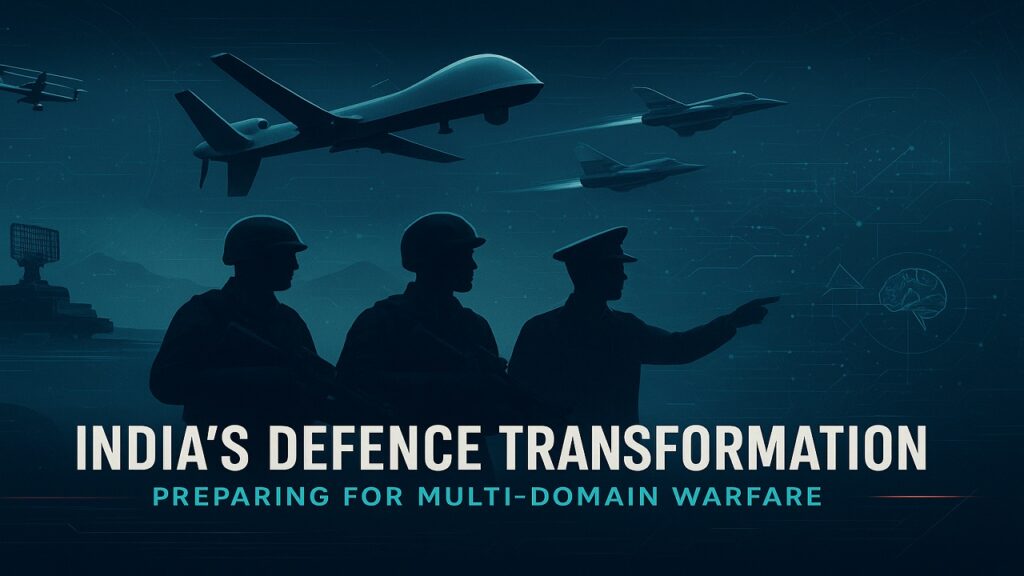
Context
- At the Combined Commanders’ Conference 2025 in Kolkata, the Prime Minister of India highlighted the urgent need for the armed forces to move from traditional service silos to integrated theatre commands.
- The focus is on enhancing jointness, leveraging advanced technology, and preparing for multi-domain warfare, reflecting the changing nature of modern conflicts.
- India must adapt its military structure, doctrines, and technology to counter evolving threats from multiple fronts and domains.
1. The Changing Nature of Warfare
- AI and Automation:
- Enables faster decision-making and autonomous operations.
- Raises ethical dilemmas and increases vulnerability to cyber sabotage.
- Drones and Precision Weapons:
- Low-cost drones and precision-guided munitions increase lethality and accessibility.
- Change traditional battlefield calculations and force deployment strategies.
- Cyber and Information Warfare:
- Conflicts now extend to digital and psychological domains.
- Misinformation and hacking can disable critical infrastructure without firing a shot.
- Two-Front Threat:
- India faces potential simultaneous pressure from China and Pakistan.
- Requires jointness, structural reforms, and technology-driven preparedness.
2. From Coordination to Command
- Theatre Commands Push:
- PM of India urged a shift from service coordination to integrated theatre commands for unified operational control.
- Inter-Services Rules 2025:
- Commanders now have administrative and disciplinary authority, ensuring true jointness in operations.
- Tri-Service Agencies:
- Cyber, space, and special operations wings under HQ IDS enhance integrated defence readiness.
- Modular Battle Groups:
- Units like “Rudra” and “Bhairav” integrate infantry, armour, artillery, and surveillance for rapid mission-specific deployment.
- Amphibious Doctrine:
- Provides land-air-sea synergy, though India still lags behind China in fully integrated commands.
3. Doctrinal and Technological Evolution
- Joint Doctrines Modernisation:
- 2017 and 2018 doctrines laid foundations for synergy but require modernisation for multi-domain warfare.
- Ran Samvad Seminar:
- Emphasized building “hybrid warriors” skilled in tactics, coding, cyber, and information warfare.
- Key Platforms and Systems:
- MQ-9B Drones: Provide persistent ISR and precision strike, enhancing tri-service operations.
- Rafale-M Jets: Boost carrier aviation, improving maritime strike and fleet air defence.
- Akashteer AI Network: Integrates Army air defence with IAF command systems, enabling fast and automated responses.
4. Creating a Modern Force
- Integrated Battle Groups:
- “Rudra” brigades designed for deployment within 12–48 hours, combining multi-domain assets for rapid response.
- Pralay Missile Trials:
- Quasi-ballistic missiles expand land-based theatre strike capability against hardened targets.
- Carrier-Centric Navy:
- Rafale-M jets stabilize near-term air wings, while a 15-year roadmap charts manned and unmanned operational dominance.
- Civil-Military Fusion:
- Integration of DRDO, PSUs, private firms, and universities into professional military education (PME) accelerates innovation.
5. Way Forward
- Gradual Theatre Commands:
- Start with limited mandates, gradually expanding while balancing inter-service differences with operational needs.
- Standardised Systems:
- Implement unified data and interface protocols for seamless communication and interoperability.
- Technologist-Commanders:
- Embed AI, cyber, coding, and tech training into leadership to develop adaptive, multi-domain warriors.
- Industrial Ecosystem:
- Focus on rapid prototyping, repeated field trials, and discarding obsolete systems to maintain military agility.
Conclusion
- The future battlefield will be multi-domain, where speed, information dominance, and adaptability are as decisive as firepower.
- For India, achieving true jointness, fostering civil-military integration, and embracing technological innovation are critical to remain operationally decisive against evolving threats.
Source : The Hindu
